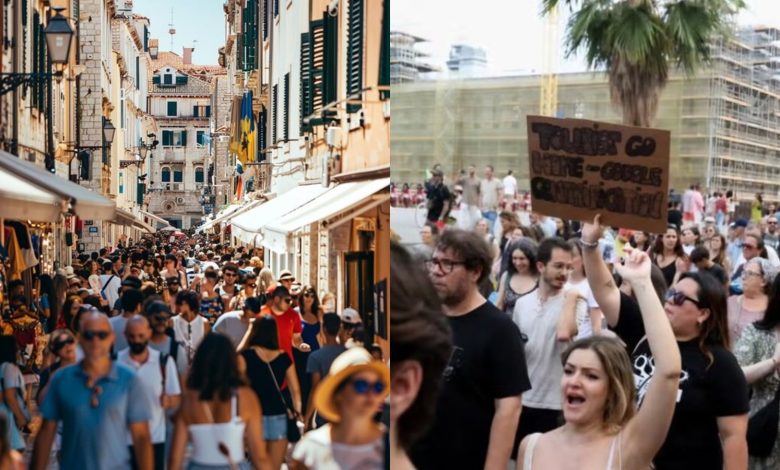Barcelona locals aggressively protest overtourism: What is it and is their aggression valid?

“Tours go home” — this was the reigning sentiment in Barcelona over the weekend as thousands of locals thronged the streets of their vibrant city to make their displeasure known to the tours passing through. Their problem? Too many tours, as much inflation and too little space. Barcelona rejects overtourism via planned protests(Freepik, X) Right off the bat, overtourism is not a new concocted phenomenon from the land of the Spaniards. Barcelona may have made the global news owing to their recently assumed aggressive stance against tours but they are not the first who are grappling with the impact of being an oft-visited tour destination. What is this brimming fiasco then all about? What is overtourism?As per the World Travel and Tourism Council (WTTC), prior to COVID-19, tourism accounted for 10.4% of the global GDP. The figure has seen a slight decline since then, standing at 9.1% for last year. Speaking of Barcelona alone, the pre-COVID era saw the city reportedly clock in €12 billion from just tourism. What then, could possibly be the city’s problem with tours arriving daily the thousands, ready to spend their money and contribute to the economy? Tours throng the famous Trevi Fountain in Rome(Solimar International) As per a National Geographic report, overtourism is best understood as “the spiraling numbers of visitors taking a toll on cities, landmarks and landscapes”. While this may not sound like a ‘problem’ warranting an orchestrated harassment of tours as took place in Barcelona over the weekend, the long-term impact of overtourism is significantly more serious than simply being bothered you favourite nooks in the city looking too congested. Why is Barcelona protesting overtourism?The main bone of contention for Barcelona has been the inflated cost of living, courtesy of the steadily growing volume of tours populating the city during peak travel season. How serious the situation is, is evident from the fact that the city has a dedicated Neighborhood Assembly for Tourism Degrowth. As nearly 3000 locals took to the streets with brightly-coloured water guns directed at tours, a 13-point manifesto was presented demanding restrictions on tour accommodations, fewer cruise terminals in the city’s port and an end to tourism advertisements using public money, as outlined The Washington Post. Crowds galore at Barcelona’s La Rambla(Shutterstock) The protests have not been in vain, with Barcelona Mayor Jaume Collboni pledging 10,000 residential units dedicated for tours to local residents instead, in tow with a significant hike in tour taxes on Saturday itself. This is also not the first step of appeasement taken authorities to quell native frustrations. As per a Bloomberg report, the rather popular bus no. #116, taking tours to Antoni Gaudí’s Park Güell, one of the most popular spots in the city, can now no longer be found on Google or Apple maps. This was orchestrated the city council with the intention of reducing neighbourhood and bus crowding making it more difficult for tours to get to the said location, momentarily pacifying the locals. Barcelona is not alone in its woesJapan’s spirit of ‘omotenashi’ is strikingly similar to India’s ‘atithi devo bhava’, with both principles honouring the sentiment of caring for guests like one’s own. This spirit in Japan however, stands significantly compromised in the face of the Yen (Japan’s currency) weakening. While Japan has for long been a sought after tour destination, it appears the scenic cities increasingly don’t appear to have the literal as well as emotional infrastructure to deal with unabashed crowding. Take the town of Fujikawaguchiko for instance which has blocked any chance of visitors managing a selfie with Mount Fuji in the backdrop, lest these antics stall traffic. Additionally, tour charges for bullet trains have shot up 70%, a rather aggressive surge. Japan’s Mount Fuji overcrowded visitors(Yamanashi Prefectural Government) Venice too, is grappling with its own overtourism woes. Estimated to be hosting about 20 million tours every year, as per a CNBC report, an ‘entry fee’ of €5 euros per person has been levied starting April 2024, which has met with a dismal response. Mayor Luigi Brugnaro clarified that the intention behind essentially locking Venice behind a paywall of sorts “is not to close the city, but not let it explode”. Venice has also fallen prey to overtourism(Skift) Be it Greece imposing a ticketing system at the famed Acropolis to control crowds, New York levying restrictions on Airbnb to allow more space for its locals or Amsterdam consciously pulling back on the construction of new hotels, it appears tours being welcomed with open arms is increasingly becoming a thing of the past. Acropolis in Greece now has a ticketing system for tours(AP) Is there a solution?George Mason University’s professor of Economics Tyler Cowen believes significantly hiking prices is a fair gamble taken tour hotspots to control crowds and simultaneously pacify locals whilst tending to the economic impact of overtourism. However, is it really ‘fair’ for the demographic of tours for whom visiting these now-seemingly ‘contested’ locations is a once-in-a-lifetime opportunity? This is of course, not to dismiss the concerns of locals who are expressing their objections to essentially losing their cities to foreigners. Whose side are you on?







